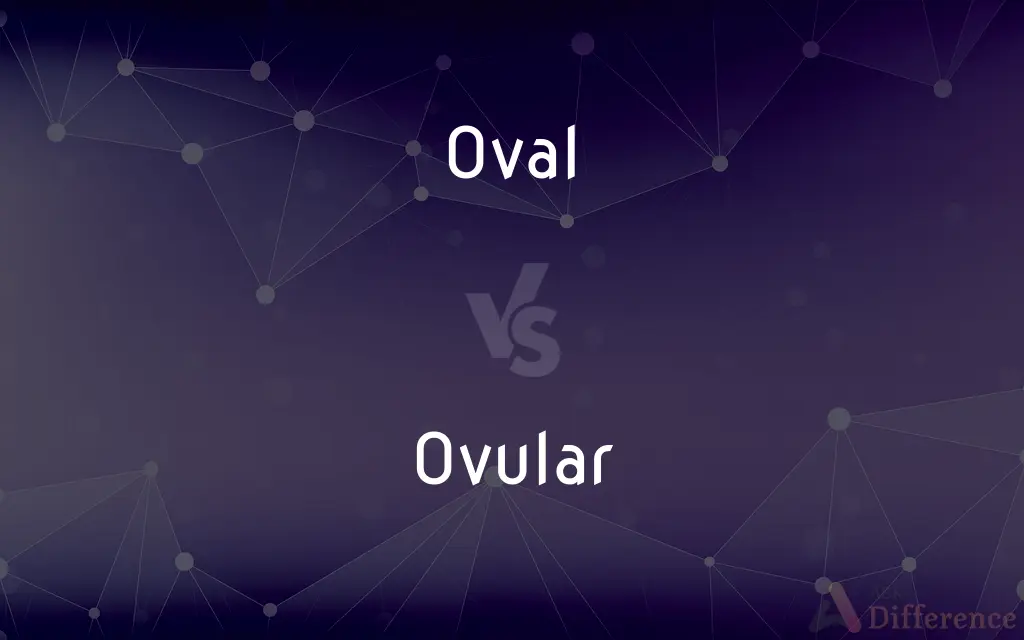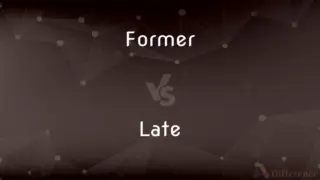Oval vs. Ovular — What's the Difference?
By Tayyaba Rehman & Fiza Rafique — Updated on July 26, 2024
Oval describes a rounded shape like an egg, commonly used in general contexts, while ovular pertains specifically to an egg shape, often used in scientific or specific discussions.

Difference Between Oval and Ovular
Table of Contents
ADVERTISEMENT
Key Differences
Oval and ovular are terms often used to describe shapes that are elongated and rounded, similar to that of an egg. However, their usage and contexts can differ. Oval is a more general term used across various fields to describe any shape that resembles an elongated circle. It is commonly used in everyday language to describe objects, designs, and patterns that have a broadly elliptical form. On the other hand, ovular is more specifically related to the shape of an egg and is often used in scientific contexts, such as in biology or anatomy, to describe objects or structures that closely resemble the shape of an actual egg.
While oval shapes are found in a wide range of objects and designs, from architecture to jewelry, ovular shapes are more specifically mentioned when the precise nature of an egg’s shape is relevant. For instance, an oval window in architecture might not precisely mimic the proportions of an egg, whereas an ovular ovum in biology is specifically described for its egg-like shape. This distinction highlights how the context can determine the choice between the two terms.
The term oval can apply to a broader range of shapes that do not strictly adhere to the exact proportions of an egg but still maintain a rounded, elongated form. In contrast, ovular suggests a closer resemblance to the specific dimensions and curvature of an egg, indicating a more narrow and precise application of the term. This specificity makes ovular a less common term in everyday language and more reserved for academic or technical descriptions where accuracy about the shape is necessary.
Both oval and ovular shapes share the characteristic of being rounded and elongated; however, the precision of the shape described by ovular makes it particularly useful for scientific or detailed discussions about shape and form. In more general and artistic contexts, oval is the preferred term due to its broader applicability and recognition in everyday language. This distinction reflects the balance between the need for precision and the need for general understanding in different contexts.
While oval is broadly used to describe any elongated, rounded shape, ovular specifies a shape that closely mimics the form of an egg. The choice between the two terms depends on the level of specificity and context in which the shape is being described, with oval serving a more general purpose and ovular reserved for more precise or scientific discussions.
ADVERTISEMENT
Comparison Chart
Definition
A shape resembling an elongated circle
Specifically related to an egg’s shape
Usage Context
Broad, general use in everyday language
Specific, often in scientific contexts
Shape Precision
General elongated and rounded form
Closer resemblance to an egg’s proportions
Common Applications
Architecture, design, everyday objects
Biology, anatomy, specific descriptions
Language Frequency
Commonly used across various contexts
Less commonly used, more technical
Compare with Definitions
Oval
A shape resembling a flattened circle.
The table was oval in shape.
Ovular
Specifically referring to an egg-like shape.
The scientist examined the ovular specimen.
Oval
Used in design and aesthetics for its pleasing proportions.
The artist preferred oval canvases for his portraits.
Ovular
Used in biology to describe cell or organ shapes.
The ovary contains several ovular follicles.
Oval
Pertains to general elongated round shapes.
The garden’s pathway was lined with oval stones.
Ovular
Less common in everyday language, more technical.
The architect used ovular forms for natural inspiration.
Oval
Broadly applicable in everyday language.
She wore an oval locket around her neck.
Ovular
Focused application in scientific contexts.
The study focused on the ovular structure of the eggs.
Oval
Commonly used to describe mirrors, frames, and windows.
She looked into the large oval mirror.
Ovular
Indicates precision in shape description.
The ovular design was chosen for its biological relevance.
Oval
An oval (from Latin ovum, "egg") is a closed curve in a plane which resembles the outline of an egg. The term is not very specific, but in some areas (projective geometry, technical drawing, etc.) it is given a more precise definition, which may include either one or two axes of symmetry of an ellipse.
Ovular
(Botany) A structure in seed plants that consists of the embryo sac surrounded by the nucellus and one or two integuments and that develops into a seed after it is fertilized.
Oval
Having a rounded and slightly elongated outline or shape like that of an egg
Her smooth oval face
Ovular
(Zoology) A small or immature ovum.
Oval
A body, object, or design with an oval shape or outline
Cut out two small ovals from the felt
Ovular
Of or pertaining to an oval.
Oval
Resembling an egg in shape.
Ovular
Of or pertaining to an ovule.
Oval
Resembling an ellipse in shape; elliptical.
Ovular
A seminar for feminists.
Oval
An egg-shaped or elliptical form or figure.
Ovular
Relating or belonging to an ovule; as, an ovular growth.
Oval
An elliptical track, as for racing or athletic events.
Ovular
Being or of the nature of an ovule
Oval
An elongated round shape resembling an egg or ellipse. Category:en:Curves
Ovular
Of or relating to an ovum
Oval
A thing having such a shape, such as an arena.
Oval
(math) In a projective plane, a set of points such that no three are collinear and there is a unique tangent line at each point.
Oval
(AU) A sports field, typically but not exclusively oval in shape.
Oval
Having the shape of an oval.
Oval
Of or pertaining to an ovum.
Oval conceptions
Oval
Of or pertaining to eggs; done in the egg, or inception; as, oval conceptions.
Oval
Having the figure of an egg; oblong and curvilinear, with one end broader than the other, or with both ends of about the same breadth; in popular usage, elliptical.
Oval
Broadly elliptical.
Oval
A body or figure in the shape of an egg, or popularly, of an ellipse.
Oval
A closed plane curve resulting from the intersection of a circular cone and a plane cutting completely through it;
The sums of the distances from the foci to any point on an ellipse is constant
Oval
Rounded like an egg
Common Curiosities
Why is the term oval more commonly used?
Oval is more common because it applies broadly to any elongated, rounded shape, making it versatile across various contexts and languages.
Can an object be both oval and ovular?
Yes, if an object closely resembles an egg’s shape, it could be described as both oval and ovular, but ovular emphasizes a closer similarity to an egg.
Is ovular used outside of scientific contexts?
While it can be, ovular is less commonly used outside scientific or technical discussions due to its specific reference to egg-like shapes.
How is ovular different from oval?
Ovular specifically pertains to shapes that closely mimic an egg’s form, often used in scientific contexts, whereas oval is a more general term.
Are oval shapes always symmetrical?
Oval shapes are generally symmetrical along at least one axis, but the degree of symmetry can vary depending on the specific object or design.
How do designers decide between using oval or ovular shapes?
Designers might choose based on the desired precision or aesthetic effect; oval for general appeal, and ovular for specific, egg-like resemblance.
What does oval mean?
Oval refers to any shape that resembles an elongated circle, commonly used to describe rounded, elongated objects or designs.
Does the use of ovular imply a more detailed observation?
Yes, using ovular suggests a closer attention to the specific characteristics that mimic an egg’s shape, indicating a more detailed description.
Can the terms oval and ovular apply to three-dimensional objects?
Yes, both terms can describe three-dimensional objects, with oval referring to the general shape and ovular indicating a closer resemblance to an egg.
What is an example of an ovular object in nature?
An egg is the most direct example of an ovular object in nature, from which the term derives its specific meaning.
How has the use of oval and ovular shapes evolved in art and design?
The use of these shapes has evolved to incorporate modern design principles, technology, and cultural trends, maintaining their relevance and appeal across eras.
Can the terms oval and ovular be used interchangeably?
While they can be in some contexts, using ovular instead of oval provides a more precise description when the specific egg-like shape is relevant.
What makes an oval shape appealing in design?
Its balanced proportions and soft curves make the oval shape aesthetically pleasing and versatile in various design applications.
Are there geometric formulas to define oval and ovular shapes?
While there are formulas to describe elliptical or oval-like shapes, ovular shapes are more often described qualitatively based on their resemblance to an egg.
How do cultural perceptions of oval and ovular shapes differ?
Cultural perceptions can vary, but both shapes are often associated with harmony, continuity, and natural forms, making them appealing in various cultural contexts.
Share Your Discovery

Previous Comparison
Former vs. Late
Next Comparison
Jester vs. ClownAuthor Spotlight
Written by
Tayyaba RehmanTayyaba Rehman is a distinguished writer, currently serving as a primary contributor to askdifference.com. As a researcher in semantics and etymology, Tayyaba's passion for the complexity of languages and their distinctions has found a perfect home on the platform. Tayyaba delves into the intricacies of language, distinguishing between commonly confused words and phrases, thereby providing clarity for readers worldwide.
Co-written by
Fiza RafiqueFiza Rafique is a skilled content writer at AskDifference.com, where she meticulously refines and enhances written pieces. Drawing from her vast editorial expertise, Fiza ensures clarity, accuracy, and precision in every article. Passionate about language, she continually seeks to elevate the quality of content for readers worldwide.













































